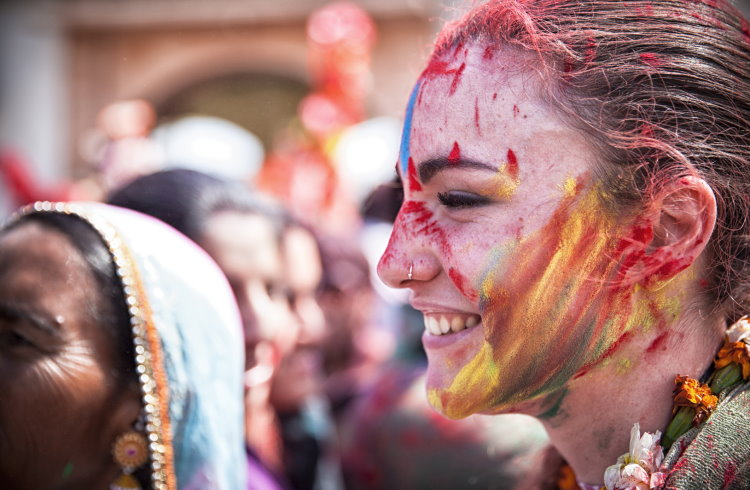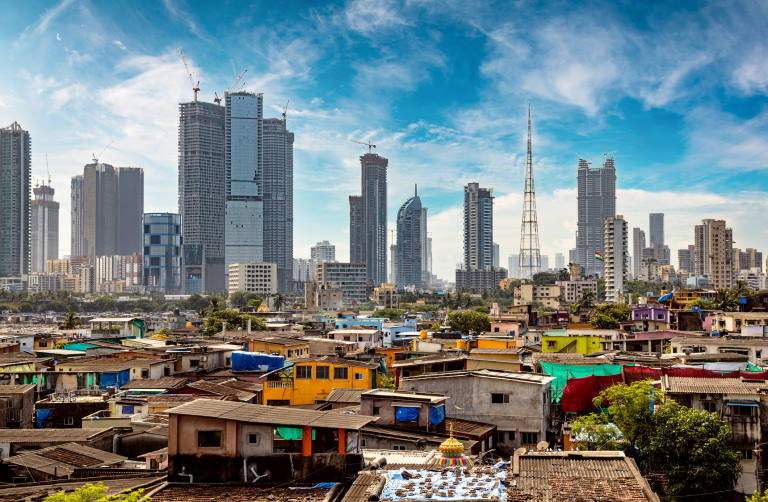Is Cultural Appropriation Ever… Appropriate?
For many of us, connecting with other cultures is one of the reasons we travel. But how can we make sure we act appropriately when visiting places with customs different to ours – and what even is cultural appropriation anyway?
 Photo © Getty Images / Satoshi-K
Photo © Getty Images / Satoshi-K
We all swim in a soup of multicultural influences, all the time, often without being aware of it. On a typical day we might say “hola!” to each other on the way to a qi gong class after which we bow our thanks to the teacher, wrap a pashmina around our shoulders and head to the nearest café for an espresso – small actions that all originated in faraway places and are now just part of life.
But what happens when, as travelers, we pick up the customs, fashions, foods, and gestures of other cultures? Is it ok to use aloha or kia ora as a greeting when you’re holidaying in Hawaii or New Zealand? To get a traditional Polynesian tattoo in Tahiti or Tonga? To visit a sweat lodge in California, wear your hair in cornrows in Jamaica or rent a kimono in Kyoto?
To find the line, if there is one, between cultural appropriation and cultural appreciation we first need to understand what cultural appropriation is, why we do it, how it might be problematic, and how we can be culturally aware as travellers.
- What is cultural appropriation?
- Connecting through culture
- The post-colonial problem
- Celebrating our shared humanity
- Appreciation, not appropriation
- Make room for individual differences
What is cultural appropriation?
It's a slippery term, says cultural tourism researcher Bobbie Chew Bigby, a Cherokee woman based in Oklahoma. “Cultural appropriation has become a really hot topic in the context of wider social issues – including multiculturalism, diversity, social justice issues and the #MeToo movement – and as a result there are a lot of diverse views in the literature on what it actually is.
“I’ve heard it defined as simply taking [elements] from cultures that are not your own as well as benefiting from aspects of cultures that are not your own – both of which seem rather broad to me. I personally define cultural appropriation as the use of or engagement with different aspects of culture in a way that is contrary to the perspectives, views, or wishes of the people to whom that culture belongs.”
Jim Butcher from the University of Christ Church in the UK and the author of The Moralisation of Tourism takes the broader view. “There is nothing really new here. The Grand Tourists of the 18th century, the sons of the aristocracy sent abroad to become cultured, returned with new fashions and ideas. In fact the meeting of cultures has been a focus for progress in ideas, art, and society throughout history. Look at the great cities built on trade routes, such as Venice, where its growth as a maritime and trading power from around the ninth century through to the Renaissance exposed the city to new ideas and styles that shaped its architecture and history, giving Venice its unique and worldly beauty.”
Connecting through culture
Why do we like to imitate other cultures? Because “we enjoy them, find them aesthetically pleasing, or because we want to pay homage to them,” says Butcher.
It’s also part of human nature, says Bobbie Bigby. “I think as humans we’ve always been curious and fascinated by other cultures and wanted to experience and connect with them by engaging with various aspects of those cultures. But now, in the modern era, globalization, the internet, international trade have all blurred these boundaries [so] I’d say that where those lines are clearest is in more traditional communities – they’re holding the boundary lines. And alongside this has been a growing awareness of social justice issues in recent years.”
Embedded in this concept of marking out one’s cultural territory is a sense of “ownership, pride and identity” in one’s culture, she adds. “For example when we talk about Native American communities in the US, different Tribal groups have different ‘regalia’, as we call our clothing, and there are particular family designs too. So even within a particular Tribe, one family can’t copy another family’s design. I’m Cherokee so I can’t wear a specific design from Seminole, Cheyenne, or Osage clothing, for example. That would just be wrong.”
The post-colonial problem
Connecting with other cultures is one of the joys of travel, but it can become problematic when picking up elements of a culture flows in one direction, as it often does in tourism. “It’s generally more well-off tourists that have the means and resources to visit a place where the people who live there don’t always have equal access to resources,” says Bigby.
Cultural appropriation has even been described as a form of neo-colonialism, reinforcing historical inequalities by reducing customs that have deep meaning for one culture to exotic curiosities for another.
Jim Butcher thinks otherwise, suggesting that focusing on cultural differences can prevent real connection between individuals. “Cultures are too often defined by their differences, with common, human struggles and aspirations ignored… [and] cultural transformation viewed as an external threat,” he says.
Celebrating our shared humanity
“I don’t see many problems with imitating elements of other cultures,” says Butcher. “In fact I think the placing of cultural identities on a pedestal through the invocation of ‘cultural appropriation’ demeans culture. There are, of course, economic injustices. There is also the suppression of cultures by authoritarian regimes. But cultural appropriation in its contemporary usage [within tourism] is most often aimed at benign, and sometimes exciting, cultural encounters. Far from being offended, people often like to see their culture adopted, even in a playful way, by others.”

We’ve all experienced this on our travels. A few years ago, I did a walking safari in Kenya with my father. It was a private trip and we had our own Maasai guide and cooks, all of whom wore traditional red robes called shuka. One morning, Dad decided to take the red blanket off his camp bed and drape it around his shoulders, Maasai style. He wasn’t entirely sure this playful gesture would be well received, but when he emerged from his tent, the Maasai men leapt from their seats by the fire, visibly delighted, and rushed over to shake Dad’s hand. One simple act had bridged the cultural chasm between us and the Maasai men.
Appreciation, not appropriation
Bobbie Bigby has three tips to improve the likelihood that something we want to do, say or wear will be seen as appropriate by the people we’re visiting:
- Check your intention. By wearing the hijab in a Muslim country, for instance, is your intention to dress modestly or are you wearing it because you think it will make a good Insta post?
- Ask yourself, “Where is the respect?” There are various ways to show respect in any culture, but if you put the host culture’s viewpoint (not your own) at the centre of what you’re doing, that will help you see if something’s ok or not.
- Communicate. If you’re staying only a short time and not with a host family, ask people who work at the hostel or hotel you’re staying at if something you want to do is ok or not. Just starting a conversation, showing an interest, can change the way we think about a place and its people.
It can help to do some research before participating in cultural experiences, says Tara Kennaway, senior product manager at Intrepid Travel, “to understand the nuances and cultural significance for the community you’re visiting”. Listening to “cultural insiders” such as local guides is also a good idea, as is traveling with tour operators that, like Intrepid, ensure their guides do regular cultural awareness training.
Make room for individual differences
Each of us has a personal line we won’t cross, too, arising from our own values, experiences, and ideas about culture – and what we feel comfortable doing. “At the end of the day, if you feel uncomfortable doing something, it’s ok to say no,” says Bigby. “Listening to your gut feeling is often a good way to navigate your way through a tricky cultural situation.”
This goes for the keepers of the culture too. While studying cultural tourism in Broome, Western Australia, earlier this year Bigby noticed non-Yawaru people using the Yawaru greeting Ngaji gurrjin (hello) around town “and everyone seemed ok with that. But there are always individual differences. If you said wado (thank you in Cherokee) to me I would welcome that, but maybe other Cherokee people wouldn’t. So it’s complicated – and context-specific.”
Besides, we learn by making mistakes, says Jim Butcher. “We may get it wrong now and again, but this is a part of being human and discovering the world for ourselves. To me, culture is less a set of things owned by a group of people and more of a fluid process. Think of the confluence of the Mississippi and Ohio rivers – each river goes its own way and has its own origin, but they are joined and the water that flows in and between each belongs to neither.”
Related articles
Simple and flexible travel insurance
You can buy at home or while traveling, and claim online from anywhere in the world. With 150+ adventure activities covered and 24/7 emergency assistance.
Get a quote


4 Comments
Cultural Appropriation is an illusion. Who knows the inner motives of anyones intentions, on how they dress, what they say or their beliefs and feelings from just observing them. We are each a unique expression of our created beauty and have the absolute freedom and joy to express with our lives, what we wear, what we eat and whatever cultural customs we desire to participate or not appreciate. Live life and bless others for their presence.
I agree with Jim Butcher. In fact I'd go further and say that so-called 'cultural appropriation' is a racist notion that has no place in human society. Culture is simply a set of ideas and all ideas should be willingly and freely shared.
“Cultural appropriation” seems to be only a thing in the US and is an American “first-world” issue. I’ve lived outside the US for many years and travelled all over the world in all types of countries. I have never seen or experienced anything except acceptance, delight, and encouragement for taking part of another’s culture in any other country. In fact, it has been encouraged. The only place I’ve ever seen any negativity of that sort is in the US. People want to get all upset in the US but they don’t see that asking to use chop sticks in a restaurant, using words in our every day vocabulary (because they have no idea of where they originate), where hummus originated from or other restaurants such as Mexican, Chinese, Indian, etc is all cultural appropriation- just some is accepted and some get pulled into some political controversy. I find it hypocritical in the US and sad. The world is a big and wonderful place with all kinds of amazing people who LOVE to share their culture with others. Too bad that isn’t how it is in the US. Sadly, I think the US just likes to complain about silly things instead of realizing there are real problems in the world.
My understanding is that cultural appropriation is taking from a different culture and profiting from that or disrespecting it and giving no credit. A good example was using a Chief for a logo for a sports team - the team was profiting while the tribe was not, the team had nothing to do with the tribe yet utilized its highest figure as a mascot. Similarly, clothing companies that take designs from indigenous people without paying royalties or even acknowledging the people who created them are profiting without any respect. As an individual traveler, wearing a kimono in Japan is not something you are profiting from, you are learning and sharing culture. If you refused to wear it correctly or intentionally harmed the kimono that would be seriously disrespectful but it would say more about you as a person than it would be appropriation.
I think people naturally want to share what they love about their culture and that's also why we love to travel. Taking something that you saw or learned or bought and then claiming it as your own creation and profiting from it is cultural appropriation. Wearing regular locally produced clothing that you bought there (that is not for any kind of special or ceremonial use) is also not appropriation and that can help local weavers, designers, artists, and creators earn a living. If you don't know if something is appropriate for a foreigner to do, just ask.